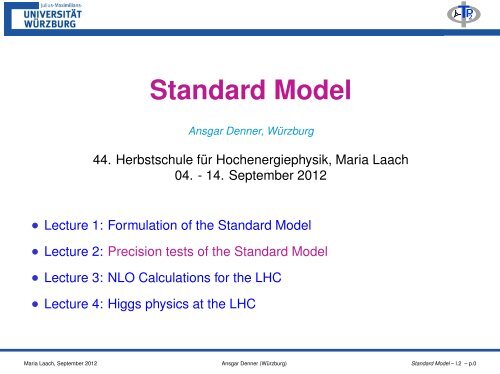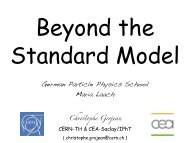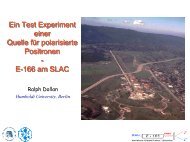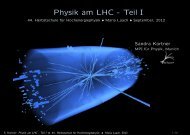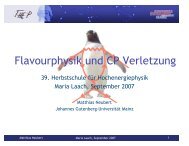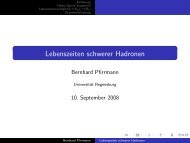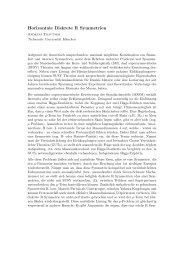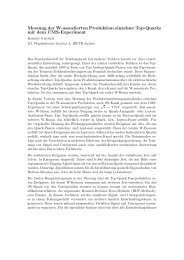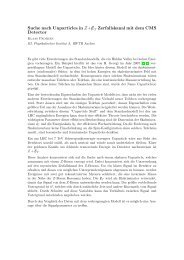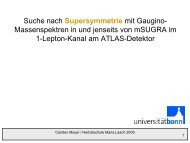Standard Model - Herbstschule Maria Laach
Standard Model - Herbstschule Maria Laach
Standard Model - Herbstschule Maria Laach
You also want an ePaper? Increase the reach of your titles
YUMPU automatically turns print PDFs into web optimized ePapers that Google loves.
<strong>Standard</strong> <strong>Model</strong><br />
Ansgar Denner, Würzburg<br />
44. <strong>Herbstschule</strong> für Hochenergiephysik, <strong>Maria</strong> <strong>Laach</strong><br />
04. - 14. September 2012<br />
Lecture 1: Formulation of the <strong>Standard</strong> <strong>Model</strong><br />
Lecture 2: Precision tests of the <strong>Standard</strong> <strong>Model</strong><br />
Lecture 3: NLO Calculations for the LHC<br />
Lecture 4: Higgs physics at the LHC<br />
Φ TP 2<br />
<strong>Maria</strong> <strong>Laach</strong>, September 2012 Ansgar Denner (Würzburg) <strong>Standard</strong> <strong>Model</strong> – l.2 – p.0
Lecture 2<br />
Precision tests of the <strong>Standard</strong> <strong>Model</strong><br />
Ansgar Denner, Würzburg<br />
44. <strong>Herbstschule</strong> für Hochenergiephysik, <strong>Maria</strong> <strong>Laach</strong><br />
04. - 14. September 2012<br />
Relevance of radiative corrections<br />
Evaluation of radiative corrections<br />
Radiative corrections to muon decay<br />
Z physics at LEP and SLC<br />
Precision tests of the <strong>Standard</strong> <strong>Model</strong><br />
Φ TP 2<br />
<strong>Maria</strong> <strong>Laach</strong>, September 2012 Ansgar Denner (Würzburg) <strong>Standard</strong> <strong>Model</strong> – l.2 – p.1
Relevance<br />
of radiative corrections<br />
Φ TP 2<br />
<strong>Maria</strong> <strong>Laach</strong>, September 2012 Ansgar Denner (Würzburg) <strong>Standard</strong> <strong>Model</strong> – l.2 – p.2
Perturbation theory and Feynman diagrams<br />
<strong>Standard</strong> <strong>Model</strong> is defined via its Lagrangian density<br />
predictions are obtained within perturbation theory<br />
Lagrangian is equivalent to Feynman rules<br />
propagators for free fields vertices for interactions<br />
e<br />
γ<br />
etc.<br />
γ<br />
Feynman diagrams provide an exact formulation of perturbation theory<br />
leading order (LO):<br />
next-to-leading order (NLO):<br />
tree diagrams<br />
loop diagrams<br />
e +<br />
e −<br />
γ<br />
e +<br />
e −<br />
e +<br />
e −<br />
e<br />
e<br />
γ<br />
e<br />
e<br />
γ<br />
etc.<br />
e +<br />
e −<br />
Φ TP 2<br />
matrix element = Mif = 〈f|M|i〉 = Σ all Feynman diagrams for |i〉 → |f〉<br />
perturbative series = series in coupling constant e or gs or both<br />
= expansion in # of loops of Feynman diagrams<br />
= expansion in powers of (quantum corrections)<br />
<strong>Maria</strong> <strong>Laach</strong>, September 2012 Ansgar Denner (Würzburg) <strong>Standard</strong> <strong>Model</strong> – l.2 – p.2
e + e − collider 1989–2000<br />
Situation at LEP<br />
events<br />
1.5×10 7 e + e − → Z → hadrons, 1.7×10 6 e + e − → Z → leptons<br />
4.8×10 4 e + e − → W + W −<br />
typical accuracies < ∼ 0.1%<br />
e + e − → Z → hadrons: ∆σ/σ ∼ 0.09%<br />
∆sin 2 θ lept<br />
eff<br />
∼ 0.03%<br />
e + e − → W + W − : ∆σ/σ ∼ 1%<br />
∆MW/MW ∼ 0.05%<br />
predictions are calculated within perturbation theory<br />
expansion parameter: α/π ∼ 0.23%, α/(πsin 2 θw) ∼ 1%<br />
generic one-loop corrections: ∼ 2%<br />
generic two-loop corrections: ∼ 0.05%<br />
Φ TP 2<br />
implications<br />
complete one-loop electroweak radiative corrections (EWRC) mandatory<br />
for e + e − → Z (at least leading) two-loop corrections needed<br />
<strong>Maria</strong> <strong>Laach</strong>, September 2012 Ansgar Denner (Würzburg) <strong>Standard</strong> <strong>Model</strong> – l.2 – p.3
Order of magnitude<br />
∼<br />
α<br />
π<br />
... α<br />
π<br />
Relevance of electroweak radiative corrections<br />
ln E2<br />
m 2 e<br />
<br />
×O(1) ∼ [0.2%...6%]×O(1) for E = 100GeV<br />
⇒ mandatory for precision tests of the electroweak (EW) <strong>Standard</strong> <strong>Model</strong> (SM)<br />
depend on all details of the theory<br />
• top quark<br />
µ<br />
νµ<br />
∼ α<br />
π<br />
W<br />
m 2 t<br />
s 2 w M2 W<br />
t<br />
b<br />
W<br />
≈ 0.05<br />
• gauge-boson self couplings<br />
µ<br />
νµ<br />
W<br />
W W<br />
• •<br />
Z,γ<br />
e<br />
νe<br />
e<br />
νe<br />
• Higgs boson<br />
µ<br />
νµ<br />
W<br />
∼ α<br />
π ln M H<br />
M W<br />
H<br />
W<br />
W<br />
e<br />
νe<br />
• New physics (supersymmetry) ?<br />
⇒ allow for indirect experimental tests of not directly accessible quantities<br />
µ<br />
νµ<br />
W<br />
?<br />
?<br />
W<br />
e<br />
νe<br />
Φ TP 2<br />
<strong>Maria</strong> <strong>Laach</strong>, September 2012 Ansgar Denner (Würzburg) <strong>Standard</strong> <strong>Model</strong> – l.2 – p.4
Evaluation<br />
of radiative corrections<br />
Φ TP 2<br />
<strong>Maria</strong> <strong>Laach</strong>, September 2012 Ansgar Denner (Würzburg) <strong>Standard</strong> <strong>Model</strong> – l.2 – p.5
Perturbative evaluation of quantum field theories<br />
Formulate theory: Lagrangian<br />
perturbative evaluation: Feynman rules<br />
⇓<br />
quantization → gauge fixing, Faddeev–Popov ghosts<br />
⇓<br />
⇓<br />
Feynman graphs<br />
⇓<br />
loop integrals → technical problem: divergences (UV, IR)<br />
⇓<br />
regularization → divergences mathematically meaningful<br />
⇓<br />
define input parameters: renormalization → absorbs UV divergences<br />
⇓<br />
theoretical predictions: calculation of observables (cross sections, decay widths, etc.)<br />
֒→ IR divergences cancel for sufficiently inclusive<br />
quantities (e.g. inclusion of photon bremsstrahlung)<br />
Φ TP 2<br />
<strong>Maria</strong> <strong>Laach</strong>, September 2012 Ansgar Denner (Würzburg) <strong>Standard</strong> <strong>Model</strong> – l.2 – p.5
Loop integrals and regularization<br />
Observation: loop integrals involve divergences<br />
Φ TP 2<br />
ultraviolet (UV) divergences for q → ∞ (large momenta), e.g.:<br />
<br />
d 4 1<br />
q<br />
(q2 −m2 0 )((q +p)2 −m2 <br />
dq<br />
∼ for q → ∞ → logarithmic divergence<br />
1 ) q<br />
infrared (IR) divergences for q → q0 (small/collinear momenta), e.g.:<br />
<br />
d 4 1<br />
q<br />
q2 (q2 +2qp1)(q 2 +2qp2) ∼<br />
<br />
dq<br />
for q → 0 → logarithmic divergence<br />
q<br />
regularization: extension of theory by free parameter δ (cut-off) such that<br />
original theory is obtained as limiting case δ → δ0<br />
integrals (and thus the theory) become finite, i.e. well defined for δ = δ0<br />
֒→ fix input parameters xi of regularized theory (δ = δ0) by experiment<br />
⇒ observables must have finite limit δ → δ0 as functions of xi<br />
(independent of regularization scheme)<br />
relations between physical quantities should be finite and indep. of cut-off<br />
if true: theory is renormalizable<br />
<strong>Maria</strong> <strong>Laach</strong>, September 2012 Ansgar Denner (Würzburg) <strong>Standard</strong> <strong>Model</strong> – l.2 – p.6
Convenient regularization schemes<br />
Cut-off regularization: require q 2 0 +q 2 < Λ 2 in momentum space<br />
UV divergences appear as logΛ 2 , Λ 2 , . . .<br />
breaks Lorentz invariance and gauge invariance ⇒ not used<br />
dimensional regularization: switch to D = 4 space-time dimensions<br />
regularizes UV and IR divergences, respects gauge invariance, easy use<br />
prescription: (µ = arbitrary reference mass, drops out in observables)<br />
<br />
d 4 q → (2πµ) 4−D<br />
<br />
d D q and D-dim. momenta, metric, Dirac algebra<br />
and analytic continuation to continuous complex D !<br />
1<br />
divergences appear as poles<br />
4−D<br />
֒→ define ∆ ≡ 2<br />
4−D −γE +ln(4π) = 2<br />
+ const.<br />
4−D<br />
IR regularization by infinitesimal photon mass mγ<br />
and (if relevant) by small fermion mass mf<br />
prescription: photon propagator pole 1<br />
→<br />
q2 divergences appear as ln(mγ) and ln(mf) terms<br />
1<br />
q 2 −m 2 γ<br />
Φ TP 2<br />
<strong>Maria</strong> <strong>Laach</strong>, September 2012 Ansgar Denner (Würzburg) <strong>Standard</strong> <strong>Model</strong> – l.2 – p.7
Propagators and 2-point functions:<br />
Need for renormalization<br />
structure of one-loop self-energies (scalar case as example):<br />
p→<br />
= Σ(p 2 ) = C1p 2 ∆ + C2∆ + Σfinite(p 2 ) = UV divergent<br />
behaviour of propagator near pole for free propagation:<br />
G φφ (p 2 ) =<br />
i<br />
p2 −m2 +Σ(p2 ) p 2 →m 2<br />
1<br />
1+Σ ′ (m 2 )<br />
i<br />
p 2 −m 2 +Σ(m 2 )<br />
֒→ higher-order corrections change location and residue of propagator pole !<br />
interaction vertices:<br />
example: scalar 4-point interaction L φ 4 = −λφ 4 /4!<br />
Γ φφφφ (p1,p2,p3) = −iλ + iΛ(p1,p2,p3)<br />
momentum-dependent one-loop correction:<br />
Λ(p1,p2,p3) = C3∆ + Λfinite(p1,p2,p3) = UV divergent<br />
֒→ higher-order corrections change coupling strength !<br />
+<br />
Φ TP 2<br />
<strong>Maria</strong> <strong>Laach</strong>, September 2012 Ansgar Denner (Würzburg) <strong>Standard</strong> <strong>Model</strong> – l.2 – p.8
Renormalizable field theories:<br />
Structure of UV divergences<br />
UV divergences in vertex functions have analytical form of<br />
elementary vertex structures (directly related to L)<br />
֒→ idea: absorb divergences in free parameters<br />
⇒ reparametrization of theory = renormalization<br />
different types of renormalizable theories:<br />
◮ theories with unrelated couplings of non-negative mass dimensions<br />
֒→ renormalizability proven by power counting and “BPHZ procedure”<br />
◮ gauge theories (couplings unified by gauge invariance)<br />
֒→ renormalizability non-trivial consequence of gauge symmetry ‘t Hooft ’71<br />
non-renormalizable field theories:<br />
e.g. theories with couplings of negative mass dimensions<br />
(cf. Fermi model, effective field theories)<br />
operators of higher and higher mass dimensions needed to absorb<br />
UV divergences in higher orders<br />
֒→ infinitely many free parameters, much less predictive power<br />
Φ TP 2<br />
<strong>Maria</strong> <strong>Laach</strong>, September 2012 Ansgar Denner (Würzburg) <strong>Standard</strong> <strong>Model</strong> – l.2 – p.9
Practical procedure for renormalization<br />
Consider original (“bare”) parameters and fields as preliminary<br />
(denoted with subscripts “0” in the following)<br />
Φ TP 2<br />
֒→ introduce new “renormalized” parameters and fields that obey certain conditions<br />
propagators and 2-point functions:<br />
mass renormalization: m 2 0 = m 2 +δm 2 ,<br />
m 2 ! = location of propagator pole = “physical mass” → δm 2 = Σ(m 2 )<br />
field renormalization: rescale fields φ0 = Zφφ, G φφ = Z −1<br />
φ Gφ0φ0<br />
fix Zφ = 1+δZφ such that residue of G φφ at p 2 = m 2 equals 1<br />
֒→ δZφ = −Σ ′ (m 2 )<br />
⇒ renormalized propagator G φφ is UV finite:<br />
G φφ (p 2 i<br />
) =<br />
p2 −m2 +Σren(p2 ) ,<br />
renormalized self energy<br />
Σren(p 2 ) = Σ(p 2 )−δm 2 +(p 2 −m 2 )δZφ = Σ(p 2 )−Σ(m 2 )−(p 2 −m 2 )Σ ′ (m 2 )<br />
= Σfinite(p 2 )−Σfinite(m 2 )−(p 2 −m 2 )Σ ′ finite(m 2 ) = UV finite<br />
<strong>Maria</strong> <strong>Laach</strong>, September 2012 Ansgar Denner (Würzburg) <strong>Standard</strong> <strong>Model</strong> – l.2 – p.10
Vertex functions for interactions:<br />
Practical procedure for renormalization<br />
coupling-constant renormalization: λ0 = λ+δλ<br />
fix δλ such that λ assumes a measured value for special kinematics p exp<br />
i<br />
(renormalization point)<br />
note: Γ φφφφ = Z 2 φΓ φ0φ0φ0φ0<br />
֒→ δλ = −2δZφλ−Λ(p exp<br />
1 ,p exp<br />
2 ,p exp<br />
3 )<br />
⇒ renormalized vertex function is UV finite:<br />
Γ φφφφ (p1,p2,p3) = −iλ+iΛren(p1,p2,p3),<br />
Λren(p1,p2,p3) = Λ(p1,p2,p3)−δλ−2δZφλ<br />
= Λfinite(p1,p2,p3) − Λfinite(p exp<br />
1 ,p exp<br />
2 ,p exp<br />
3 ) = UV finite<br />
֒→ all divergences of φ 4 theory can be absorbed by renormalization of parameters<br />
(masses and coupling constants) and the fields (δm,δλ,δZφ)<br />
Φ TP 2<br />
Any physical observable calculated in terms of renormalized parameters is finite and<br />
well-defined (although affected by a systematic perturbative uncertainty).<br />
<strong>Maria</strong> <strong>Laach</strong>, September 2012 Ansgar Denner (Würzburg) <strong>Standard</strong> <strong>Model</strong> – l.2 – p.11
Renormalization of the <strong>Standard</strong> <strong>Model</strong><br />
Bare input parameters: e0,MW,0,MZ,0,MH,0,mf,0,Vij,0<br />
renormalization transformation:<br />
parameter renormalization:<br />
e0=(1+δZe)e,<br />
M 2 W,0=M 2 W +δM 2 W, M 2 Z,0=M 2 Z +δM 2 Z, M 2 H,0=M 2 H +δM 2 H,<br />
mf,0=mf +δmf, Vij,0=Vij +δVij, (both Vij,0,Vij unitary)<br />
note: renormalization of cw,sw fixed by on-shell condition cw = MW/MZ<br />
(sw is not a free parameter if MW, MZ are used as input parameters)<br />
field renormalization: (physical fields)<br />
W ±<br />
0 =√ZW W ± √ √ <br />
Z0 ZZZ ZZA Z<br />
, = √ √ , H0=<br />
A0 ZAZ ZAA A<br />
√ ZH H,<br />
ψ L <br />
f,0= ZL ff ′ ψ L<br />
f ′, ψR <br />
f,0= ZR ff ′ ψ R<br />
f ′,<br />
note: matrix renormalization necessary to account for loop-induced mixing<br />
Φ TP 2<br />
<strong>Maria</strong> <strong>Laach</strong>, September 2012 Ansgar Denner (Würzburg) <strong>Standard</strong> <strong>Model</strong> – l.2 – p.12
Renormalization of the <strong>Standard</strong> <strong>Model</strong><br />
Bare input parameters: e0,MW,0,MZ,0,MH,0,mf,0,Vij,0,gs<br />
renormalization transformation:<br />
parameter renormalization:<br />
e0=(1+δZe)e, gs,0=(1+δZgs)gs,<br />
M 2 W,0=M 2 W +δM 2 W, M 2 Z,0=M 2 Z +δM 2 Z, M 2 H,0=M 2 H +δM 2 H,<br />
mf,0=mf +δmf, Vij,0=Vij +δVij, (both Vij,0,Vij unitary)<br />
note: renormalization of cw,sw fixed by on-shell condition cw = MW/MZ<br />
(sw is not a free parameter if MW, MZ are used as input parameters)<br />
field renormalization: (physical fields)<br />
W ±<br />
0 =√ZW W ± √ √ <br />
Z0 ZZZ ZZA Z<br />
, = √ √ , H0=<br />
A0 ZAZ ZAA A<br />
√ ZH H,<br />
ψ L <br />
f,0= ZL ff ′ ψ L<br />
f ′, ψR <br />
f,0= ZR ff ′ ψ R<br />
f ′, Aa0 = √ ZAA a<br />
note: matrix renormalization necessary to account for loop-induced mixing<br />
Φ TP 2<br />
<strong>Maria</strong> <strong>Laach</strong>, September 2012 Ansgar Denner (Würzburg) <strong>Standard</strong> <strong>Model</strong> – l.2 – p.12
Mass renormalization:<br />
Renormalization conditions<br />
on-shell definition: mass 2 is location of pole in propagator<br />
֒→ δM 2 W = Re{Σ W T (M 2 W)}, similar expressions for δM 2 Z,δM 2 H,δmf<br />
note: ⋄ location of pole is complex for unstable particles<br />
֒→ important for processes with unstable-particle production<br />
(gauge-invariant definition: mass 2 as real part of pole location)<br />
⋄ other definitions of quark masses often more appropriate<br />
(e.g. running masses)<br />
field renormalization: (bosons and leptons)<br />
◮ residues of propagators (diagonal, transverse parts) normalized to 1<br />
W ′<br />
֒→ δZW = −Re{ΣT (M 2 W)},<br />
similar expressions for δZAA,δZZZ,δZH,δZ L/R<br />
ff<br />
◮ suppression of mixing propagators on particle poles<br />
physical on-shell particles do not mix<br />
֒→ fixes non-diagonal constants δZAZ,δZZA,δZ L/R<br />
ff ′ (f = f ′ )<br />
note: problems for unstable particles beyond one loop<br />
(field-renormalization constants become complex)<br />
Φ TP 2<br />
<strong>Maria</strong> <strong>Laach</strong>, September 2012 Ansgar Denner (Würzburg) <strong>Standard</strong> <strong>Model</strong> – l.2 – p.13
Renormalization conditions (cont.)<br />
Charge renormalization: define e in Thomson limit (low-energy-elastic scattering)<br />
e<br />
e<br />
k<br />
Aµ<br />
k→0<br />
−→ ieγµ for on-shell electrons<br />
֒→ e = elementary charge of classical electrodynamics<br />
fine-structure constant α(0) = e2<br />
= 1/137.03599976<br />
4π<br />
gauge invariance relates δZe to photon field renormalization:<br />
δZe = − 1<br />
2 δZAA − sw<br />
δZZA (at one loop)<br />
2cw<br />
CKM-matrix renormalization → fixes δVij<br />
rotation to mass eigenstates;<br />
CKM part requires a careful (non-trivial) investigation<br />
of mixing energies, mass eigenstates, LSZ reduction, etc.<br />
general result: all renormalization constants can be obtained from self-energies.<br />
different renormalization schemes are possible<br />
Φ TP 2<br />
<strong>Maria</strong> <strong>Laach</strong>, September 2012 Ansgar Denner (Würzburg) <strong>Standard</strong> <strong>Model</strong> – l.2 – p.14
Renormalization of strong coupling<br />
QCD becomes strongly interacting for small momentum transfers<br />
quarks and gluons are confined in hadrons<br />
֒→ on-shell renormalization makes no sense<br />
֒→ no obvious renormalization point for strong coupling<br />
renormalization schemes for QCD<br />
momentum subtraction scheme (MOM): choose symmetric Euclidean<br />
renormalization point, p 2 i = −M2 , for vertex functions<br />
minimal subtraction scheme (MS):<br />
subtract only UV divergences 1/(D −4)<br />
modified minimal subtraction scheme (MS): commonly used<br />
subtract ∆ (UV-divergences plus some universal constants)<br />
renormalized results depend on scale µ of dimensional regularization<br />
⇒ renormalization-scale dependence of observables<br />
renormalization constant δgs can be determined from one vertex function<br />
q<br />
g<br />
g or g<br />
q<br />
g<br />
Φ TP 2<br />
<strong>Maria</strong> <strong>Laach</strong>, September 2012 Ansgar Denner (Würzburg) <strong>Standard</strong> <strong>Model</strong> – l.2 – p.15
IR divergences and photon bremsstrahlung<br />
Consider processes with charged external particles, e.g., e + e − → µ + µ −<br />
virtual corrections: loop diagrams<br />
IR divergences from soft virtual photons (q → 0)<br />
<br />
d 4 q<br />
(q2 −m2 γ)(q2 +2qp1)(q 2 → Cln(mγ)<br />
+2qp2)<br />
“real” corrections: photon bremsstrahlung = “real” radiative corrections<br />
d 3 q<br />
2q0<br />
Bloch–Nordsieck theorem:<br />
2 IR divergences from soft real photons (q → 0)<br />
<br />
d 3 q<br />
→ −Cln(mγ)<br />
q2 +m2 γ(2qp1)(2qp2)<br />
IR divergences of virtual and real corrections cancel in the sum<br />
֒→ virtual and soft-photonic corrections cannot be discussed separately<br />
are related due to limited experimental resolution of soft photons<br />
֒→ cross-section predictions necessarily depend on treatment of photon<br />
emission (energy and angular cuts)<br />
Φ TP 2<br />
<strong>Maria</strong> <strong>Laach</strong>, September 2012 Ansgar Denner (Würzburg) <strong>Standard</strong> <strong>Model</strong> – l.2 – p.16
Radiative corrections<br />
to muon decay<br />
Φ TP 2<br />
<strong>Maria</strong> <strong>Laach</strong>, September 2012 Ansgar Denner (Würzburg) <strong>Standard</strong> <strong>Model</strong> – l.2 – p.17
Gauge-boson-mass relation<br />
MW and MZ correlated via muon lifetime ↔ Fermi constant Gµ<br />
Fermi model<br />
<strong>Standard</strong> <strong>Model</strong><br />
µ −<br />
νe<br />
τ −1<br />
µ = G2 µm 5 µ<br />
192π 3<br />
µ −<br />
νe<br />
Gµ = πα<br />
√ 2<br />
νµ<br />
e −<br />
µ −<br />
νµ νe<br />
W +<br />
e −<br />
e −<br />
νµ<br />
<br />
1−8 m2e m2 <br />
(1+δQED)<br />
µ<br />
µ −<br />
νe<br />
1<br />
M 2 W (1−M2 W /M2 Z )<br />
∆r: calculable quantum corrections<br />
loops<br />
1<br />
1−∆r<br />
(beyond electromagnetic corrections to Fermi model)<br />
νµ<br />
e −<br />
Φ TP 2<br />
<strong>Maria</strong> <strong>Laach</strong>, September 2012 Ansgar Denner (Würzburg) <strong>Standard</strong> <strong>Model</strong> – l.2 – p.17
Virtual correction – one-loop diagrams:<br />
Σ W<br />
T (s)<br />
W self-energy<br />
Electroweak corrections to µ decay<br />
W<br />
Wlνl vertex correction<br />
real correction – one-photon bremsstrahlung:<br />
µ<br />
νµ<br />
W<br />
W<br />
γ<br />
e<br />
νe<br />
µ<br />
νµ<br />
W<br />
e<br />
γ<br />
νe<br />
W<br />
box diagrams<br />
consistent use of Gµ:<br />
photonic QED corrections are treated in<br />
the Fermi model and subtracted from∆r etc.<br />
e<br />
µ<br />
νµ<br />
W<br />
µ<br />
γ<br />
e<br />
νe<br />
Φ TP 2<br />
<strong>Maria</strong> <strong>Laach</strong>, September 2012 Ansgar Denner (Würzburg) <strong>Standard</strong> <strong>Model</strong> – l.2 – p.18
W-boson self-energy:<br />
H,χ<br />
W W<br />
φ<br />
W<br />
W<br />
H,χ<br />
Feynman diagrams for vertex functions<br />
φ<br />
W W<br />
u−<br />
W<br />
W<br />
uγ,uZ<br />
Weνe vertex correction:<br />
H,χ<br />
W<br />
φ<br />
e<br />
e W<br />
νe<br />
box diagrams:<br />
µ<br />
µ<br />
νµ<br />
e<br />
νe<br />
γ,Z<br />
W<br />
e<br />
e<br />
νe<br />
e<br />
Z W<br />
νe<br />
µ<br />
νµ<br />
νµ<br />
φ<br />
Z<br />
γ,Z<br />
W W<br />
u+<br />
W<br />
W<br />
uγ,uZ<br />
e<br />
νe<br />
W<br />
W<br />
νe<br />
W<br />
Z<br />
e<br />
νe<br />
νe<br />
H<br />
W<br />
W W<br />
W<br />
e<br />
νe<br />
W<br />
γ,Z<br />
W<br />
e W<br />
µ<br />
νµ<br />
νµ<br />
W<br />
Z<br />
γ,Z<br />
e<br />
φ<br />
W<br />
W<br />
e<br />
νe<br />
l<br />
νl<br />
γ,Z<br />
e<br />
νe<br />
φ<br />
W<br />
W<br />
γ,Z<br />
e<br />
W<br />
W<br />
µ<br />
µ<br />
νµ<br />
W<br />
W<br />
Z<br />
νe<br />
W<br />
d<br />
u<br />
W<br />
H<br />
e<br />
νe<br />
W<br />
W<br />
e W<br />
e<br />
νe<br />
W<br />
Z<br />
e<br />
νe<br />
νe<br />
Φ TP 2<br />
<strong>Maria</strong> <strong>Laach</strong>, September 2012 Ansgar Denner (Würzburg) <strong>Standard</strong> <strong>Model</strong> – l.2 – p.19
O(α) corrections:<br />
∆α(M 2 Z<br />
Structure of electroweak corrections toµdecay<br />
∆r1-loop = ∆α(M2 Z ) −<br />
Sirlin ’80, Marciano, Sirlin ’80<br />
c2 w<br />
s2 ∆ρ + ∆rrem(MH)<br />
w<br />
∼ 6% ∼ 3% ∼ 1%<br />
αln(mf/MZ) Gµm 2 t αln(MH/MZ)<br />
γ<br />
f<br />
f<br />
γ W<br />
): contribution of running electromagnetic coupling<br />
∆α(M2 α<br />
Z ) ∼ 3π<br />
<br />
f Q2 f<br />
ln M2<br />
Z<br />
m 2 f<br />
֒→ large effects from small fermion masses<br />
∆ρ: leading corrections to the ρ-parameter<br />
ZZ ΣT (0)<br />
∆ρtop ∼<br />
M2 −<br />
Z<br />
ΣWW T (0)<br />
M2 <br />
∼<br />
W<br />
3Gµm2 t<br />
8 √ 2π2 ֒→ large effects from top–bottom loops in W self-energy Veltman ’77<br />
top<br />
b<br />
t<br />
W<br />
Φ TP 2<br />
<strong>Maria</strong> <strong>Laach</strong>, September 2012 Ansgar Denner (Würzburg) <strong>Standard</strong> <strong>Model</strong> – l.2 – p.20
∆α (5)<br />
had<br />
֒→ ∆α (5)<br />
had<br />
Hadronic contributions<br />
∆α(s) = −Re{Σ AA<br />
T,ren(s)/s} = −Re{Σ AA<br />
T (s)/s}+(Σ AA<br />
T ) ′ (0)<br />
= ∆αlept(s)+∆α (5)<br />
had (s)+∆αtop(s) ∼ α<br />
3π<br />
becomes sensitive to unphysical quark masses mq<br />
not calculable in perturbation theory<br />
solution: ∆α (5)<br />
had<br />
dispersion relation<br />
<br />
f<br />
Q 2 f ln M2 Z<br />
m 2 f<br />
obtainable from fit to experimental data with subtracted<br />
∆α (5)<br />
had<br />
= − α<br />
3π M2 Z Re<br />
∞<br />
4m 2 π<br />
ds ′<br />
R(s) = σ(e+ e − → γ ∗ → hadrons)<br />
σ(e + e − → γ ∗ → µ + µ − )<br />
R(s ′ )<br />
s ′ (s ′ −M 2 Z −iε)<br />
<br />
R(s) is taken from perturbative QCD for high energies ( √ s > ∼ 13GeV)<br />
⇒ ∆α (5)<br />
= 0.027498±0.000135<br />
had<br />
Jegerlehner; Burkhardt, Pietrzyk; Eidelman; Davier, Höcker,. . .<br />
Φ TP 2<br />
<strong>Maria</strong> <strong>Laach</strong>, September 2012 Ansgar Denner (Würzburg) <strong>Standard</strong> <strong>Model</strong> – l.2 – p.21
ΦTP 2<br />
Experimental confirmation of quantum corrections<br />
1−∆r = πα<br />
√ 2Gµ<br />
1<br />
M 2 W (1−M2 W /M2 Z )<br />
⇒ experimental determination of ∆r ∆r = 0.0350±0.0009<br />
∆r = 0 with 39σ ⇒ confirmation of quantum corrections<br />
∆r = ∆α ∼ 0.0594 wity 27σ ⇒ confirmation of weak corrections<br />
∆r<br />
<br />
<br />
(∆r)SM<br />
(∆r)exp<br />
<br />
∆mt<br />
<br />
mt = 173.2±0.9GeV<br />
Hollik ’00<br />
MH =<br />
1TeV<br />
⇒ limits on mt<br />
limits on MH<br />
113GeV<br />
mt [GeV]<br />
<strong>Maria</strong> <strong>Laach</strong>, September 2012 Ansgar Denner (Würzburg) <strong>Standard</strong> <strong>Model</strong> – l.2 – p.22
Z physics<br />
at LEP and SLC<br />
Φ TP 2<br />
<strong>Maria</strong> <strong>Laach</strong>, September 2012 Ansgar Denner (Würzburg) <strong>Standard</strong> <strong>Model</strong> – l.2 – p.23
e −<br />
e +<br />
Z<br />
(γ)<br />
f = e − ,µ − ,τ − ,q<br />
¯f = e + ,µ + ,τ + ,¯q<br />
Z-boson resonance<br />
unfolded resonance cross-section s = E 2 CMS<br />
σf(s) = 12π s<br />
M 2 Z<br />
line shape ⇒ MZ,ΓZ<br />
peak cross section σ 0<br />
⇒ Γ(Z → l + l − )/ΓZ,<br />
Γ(Z → hadrons)/ΓZ<br />
Γ(Z → e + e − )Γ(Z → f ¯ f)<br />
(s−M 2 Z )2 +s 2 Γ 2 Z /M2 Z<br />
angular distributions,<br />
polarization asymmetries<br />
⇒ effective Zf ¯ f vector and<br />
axial-vector couplings gvf , gaf<br />
σ had [nb]<br />
40<br />
30<br />
20<br />
10<br />
LEP1: ∼ 16×10 7 events<br />
(1989–1995)<br />
sΓ 2 Z<br />
= σ 0<br />
(s−M 2 Z )2 +s2Γ2 Z /M2 Z<br />
ALEPH<br />
DELPHI<br />
L3<br />
OPAL<br />
measurements, error bars<br />
increased by factor 10<br />
σ from fit<br />
QED unfolded<br />
Γ Z<br />
M Z<br />
86 88 90 92 94<br />
σ 0<br />
E cm [GeV]<br />
Φ TP 2<br />
<strong>Maria</strong> <strong>Laach</strong>, September 2012 Ansgar Denner (Würzburg) <strong>Standard</strong> <strong>Model</strong> – l.2 – p.23
Z<br />
f<br />
Z-boson width and number of light neutrinos<br />
¯f<br />
ΓZ = Γ(e − e + ,µ − µ + ,τ − τ + )<br />
<br />
leptonic<br />
+ <br />
Γ(q¯q)<br />
q<br />
<br />
hadronic<br />
+NνΓ(ν¯ν)<br />
<br />
invisible<br />
= Γhad +Γe +Γµ +Γτ +Γinv<br />
ΓZ measured from Z line shape<br />
Γhad and Γl=e,µ,τ from Rl = Γhad<br />
Γl<br />
σ had [nb]<br />
30<br />
20<br />
10<br />
0<br />
ALEPH<br />
DELPHI<br />
L3<br />
OPAL<br />
average measurements,<br />
error bars increased<br />
by factor 10<br />
and σ 0 had = 12π<br />
M 2 Z<br />
2ν<br />
3ν<br />
4ν<br />
86 88 90 92 94<br />
E cm [GeV]<br />
ΓeΓhad<br />
Γ 2 Z<br />
Fit of ΓZ, Rl, and σ 0 had yields invisible Z-decay width: Γinv = Nν Γ theory<br />
Z→ν¯ν<br />
֒→ Nν = 2.9840±0.0082<br />
Φ TP 2<br />
<strong>Maria</strong> <strong>Laach</strong>, September 2012 Ansgar Denner (Würzburg) <strong>Standard</strong> <strong>Model</strong> – l.2 – p.24
Z-boson–fermion couplings<br />
Φ TP 2<br />
Z physics tests predominantly effective Z-boson–fermion couplings (on-shell)<br />
Z<br />
f<br />
¯f<br />
e<br />
= i γµ(gvf −gaf γ5)<br />
2swcw<br />
effective couplings contain weak corrections to on-shell Z ¯ ff vertex<br />
Z-boson width<br />
Γ(Z → f ¯ f) = GµM3 Z<br />
6π √ <br />
(gvf<br />
2<br />
)2 +(gaf )2 (1+δ QED<br />
f )<br />
forward–backward asymmetry<br />
A f<br />
FB = σf(θ < 90 ◦ )−σf(θ > 90 ◦ )<br />
σf(θ < 90 ◦ )+σf(θ > 90 ◦ )<br />
contribution of Z-boson exchange (pseudo observable)<br />
⇒ gvf<br />
, gaf<br />
A f<br />
FB (s = M2 Z) = 3<br />
4<br />
gve/gae<br />
(gve/gae) 2 +1<br />
gvf /gaf<br />
(gvf /gaf )2 +1<br />
<strong>Maria</strong> <strong>Laach</strong>, September 2012 Ansgar Denner (Würzburg) <strong>Standard</strong> <strong>Model</strong> – l.2 – p.25
-0.032<br />
-0.035<br />
g Vl<br />
-0.038<br />
l + l −<br />
e + e −<br />
µ + µ −<br />
τ + τ −<br />
EffectiveZ-boson couplings<br />
LEPEWWG ’05<br />
-0.041<br />
-0.503 -0.502 -0.501 -0.5<br />
g Al<br />
m t = 178.0 ± 4.3 GeV<br />
m H = 114...1000 GeV<br />
m t<br />
m H<br />
∆α<br />
68% CL<br />
parameters<br />
mt = 178.0±4.3GeV<br />
MH = 114...1000GeV<br />
∆αhad = 0.02758±0.00035<br />
confirmation of<br />
lepton universality<br />
constraints onmt andMH<br />
experimental results<br />
for couplings<br />
gal<br />
gvl<br />
= −0.50123±0.00026<br />
= −0.03783±0.00041<br />
Φ TP 2<br />
<strong>Maria</strong> <strong>Laach</strong>, September 2012 Ansgar Denner (Würzburg) <strong>Standard</strong> <strong>Model</strong> – l.2 – p.26
Lowest order:<br />
Effective fermionic weak mixing angle<br />
gaf,0 = I 3 w,f, gvf,0 = (I 3 w,f −2Qfsin 2 θw)<br />
definition of effective fermionic mixing angle (pseudo observable)<br />
gaf = √ ρfI 3 w,f, gvf = √ ρf(I 3 w,f −2Qfsin 2 θ f eff)<br />
gvf ,gaf ⇒ sin2 θ f eff , ρf, gvf /gaf ⇒ sin2 θ f eff = I3 w,f<br />
2Qf<br />
lowest-order perturbation theory:<br />
including weak corrections:<br />
experiment:<br />
sin 2 θ f eff = sin 2 θw = 1− M2 W<br />
M 2 Z<br />
<br />
1− gv f<br />
ga f<br />
, ρf = 1<br />
sin 2 θ f eff = sin 2 θw, ρf = 1<br />
sin 2 θ lept<br />
eff ≈ 0.2315, sin2 θw ≈ 0.2229, sin 2 θ lept<br />
eff /sin2 θw ≈ 1.039<br />
ρf ≈ 1.005<br />
<br />
Φ TP 2<br />
<strong>Maria</strong> <strong>Laach</strong>, September 2012 Ansgar Denner (Würzburg) <strong>Standard</strong> <strong>Model</strong> – l.2 – p.27
sin 2 θ lept<br />
eff<br />
0.233<br />
0.232<br />
0.231<br />
Effective mixing angle versus leptonic ρ parameter<br />
∆α<br />
LEPEWWG ’05<br />
m t = 178.0 ± 4.3 GeV<br />
m H = 114...1000 GeV<br />
m H<br />
68% CL<br />
1 1.002 1.004 1.006<br />
ρ l<br />
m t<br />
parameters<br />
mt = 178.0±4.3GeV<br />
MH = 114...1000GeV<br />
∆αhad = 0.02758±0.00035<br />
preference for light Higgs<br />
boson<br />
experimental results<br />
Φ TP 2<br />
sin 2 θ lept<br />
eff = 0.23153±0.00016<br />
ρl = 1.0050±0.0010<br />
<strong>Maria</strong> <strong>Laach</strong>, September 2012 Ansgar Denner (Würzburg) <strong>Standard</strong> <strong>Model</strong> – l.2 – p.28
Precision tests<br />
of the <strong>Standard</strong> <strong>Model</strong><br />
Φ TP 2<br />
<strong>Maria</strong> <strong>Laach</strong>, September 2012 Ansgar Denner (Würzburg) <strong>Standard</strong> <strong>Model</strong> – l.2 – p.29
Global electroweak fit<br />
calculate all precision observables in SM including quantum corrections in<br />
terms of α(MZ), Gµ, MZ, mf=t, mt, MH, αs(MZ)<br />
determine parameters by fit to all precision data<br />
results<br />
good agreement between SM and data at the per-mille level<br />
(some exceptions)<br />
indirect determination of parameters<br />
all Z-pole data data, MW, ΓW: ⇒ mt = 179 +12<br />
−9 GeV<br />
1994: mt = 169 +24<br />
−27<br />
(top discovery 1995)<br />
present experimental value: mt = 173.2±0.9GeV<br />
all Z-pole data data, MW, ΓW, mt<br />
⇒ MH = 94 +29<br />
−24 GeV<br />
MH < 152GeV (95% C.L.) preference for light Higgs boson<br />
αs(MZ) = 0.1185±0.0026<br />
Φ TP 2<br />
<strong>Maria</strong> <strong>Laach</strong>, September 2012 Ansgar Denner (Würzburg) <strong>Standard</strong> <strong>Model</strong> – l.2 – p.29
LEPEWWG ’12<br />
∆α had (mZ )<br />
(5)<br />
Measurement Fit |O meas −O fit |/σ meas<br />
0 1 2 3<br />
0.02750 ± 0.00033 0.02759<br />
m Z [GeV] 91.1875 ± 0.0021 91.1874<br />
Γ Z [GeV] 2.4952 ± 0.0023 2.4959<br />
σ σhad [nb]<br />
0<br />
41.540 ± 0.037 41.478<br />
R l 20.767 ± 0.025 20.742<br />
A Afb 0,l<br />
0.01714 ± 0.00095 0.01645<br />
A l (P τ ) 0.1465 ± 0.0032 0.1481<br />
R b 0.21629 ± 0.00066 0.21579<br />
R c<br />
A Afb 0.1721 ± 0.0030 0.1723<br />
0,b<br />
0.0992 ± 0.0016 0.1038<br />
A Afb 0,c<br />
0.0707 ± 0.0035 0.0742<br />
A b 0.923 ± 0.020 0.935<br />
A c 0.670 ± 0.027 0.668<br />
A l (SLD) 0.1513 ± 0.0021 0.1481<br />
sin 2 sin θeff 2 θ lept (Qfb ) 0.2324 ± 0.0012 0.2314<br />
m W [GeV] 80.385 ± 0.015 80.377<br />
Γ W [GeV] 2.085 ± 0.042 2.092<br />
m t [GeV] 173.20 ± 0.90 173.26<br />
March 2012<br />
Global fit of LEP data<br />
0 1 2 3<br />
good agreement<br />
best fit for Higgs-boson mass:<br />
MH = 94 +29<br />
−24 GeV,<br />
MH < 152GeV @ 95% CL<br />
direct search at LEP2<br />
( e + e − → ZH) LEPHIGGS ’03<br />
MH > 114.4GeV<br />
Higgs discovery at LHC<br />
ATLAS/CMS July ’12<br />
MH ≈ 125GeV<br />
Φ TP 2<br />
<strong>Maria</strong> <strong>Laach</strong>, September 2012 Ansgar Denner (Würzburg) <strong>Standard</strong> <strong>Model</strong> – l.2 – p.30
Input-parameter scheme<br />
Natural input parameters: α, MW, MZ, mf, MH, αs<br />
weak mixing angle: on-shell definition sinθw = 1−M 2 W /M2 Z<br />
alternative input parameter sets: Gµ instead of MW or α<br />
Gµ no fundamental parameter, but precisely measured in µ decay<br />
definition of α<br />
◮ on-shell: α(0)<br />
appropriate for external photons<br />
◮ α(MZ), α( √ s):<br />
α(MZ)<br />
α(0)<br />
≈ 1.06<br />
absorbs running of α from Q = 0 to EW scale<br />
appropriate for internal photons and weak bosons<br />
◮ Gµ scheme: αGµ = √ 2GµM 2 W (1−M2 W /M2 Z )/π:<br />
αGµ<br />
α(0)<br />
≈ 1.03<br />
Φ TP 2<br />
absorbs running of α from Q = 0 to EW scale and ∆ρ in Wf ¯ f ′ coupling<br />
appropriate for processes with W bosons<br />
suitable choice of α reduces missing higher-order corrections<br />
gauge invariance demands unique input-parameter set!<br />
<strong>Maria</strong> <strong>Laach</strong>, September 2012 Ansgar Denner (Würzburg) <strong>Standard</strong> <strong>Model</strong> – l.2 – p.31
Conclusions<br />
<strong>Standard</strong> <strong>Model</strong> established as a quantum field theory<br />
in agreement with all experiments (accuracy > ∼ 0.1%)<br />
quantum corrections = radiative corrections are established<br />
indirect and direct determinations of mt agree<br />
constraints on the Higgs-boson mass ⇒ light Higgs boson<br />
triple-gauge-boson self-interactions established at per-cent level<br />
candidate for Higgs boson has been found<br />
to be confirmed<br />
verification of Higgs boson<br />
measurement of Higgs-boson couplings to gauge bosons and fermions<br />
Higgs-boson self-interaction ⇒ Higgs potential<br />
Φ TP 2<br />
<strong>Maria</strong> <strong>Laach</strong>, September 2012 Ansgar Denner (Würzburg) <strong>Standard</strong> <strong>Model</strong> – l.2 – p.32
Textbooks and Reviews:<br />
Literature<br />
◮ Peskin/Schroeder, An introduction to Quantum Field Theory<br />
◮ Itzykson/Zuber, Quantum Field Theory<br />
◮ Weinberg, The Quantum Theory of Fields, Vol. 1: Foundations;<br />
The Quantum Theory of Fields, Vol. 2: Modern Applications<br />
◮ Böhm/Denner/Joos, Gauge Theories of the Strong and Electroweak Interaction<br />
◮ Collins, Renormalization<br />
Experimental results:<br />
◮ The ALEPH, DELPHI, L3, OPAL, SLD Collaborations, the LEP Electroweak<br />
Φ TP 2<br />
Working Group, the SLD Electroweak and Heavy Flavour Groups, Phys. Rept.<br />
427 (2006) 257<br />
◮ The ALEPH, CDF, D0, DELPHI, L3, OPAL, SLD Collaborations, the LEP<br />
Electroweak Working Group, the Tevatron Electroweak Working Group, and the<br />
SLD electroweak and heavy flavour groups, LEPEWWG/2010-01,<br />
http://lepewwg.web.cern.ch/LEPEWWG/<br />
<strong>Maria</strong> <strong>Laach</strong>, September 2012 Ansgar Denner (Würzburg) <strong>Standard</strong> <strong>Model</strong> – l.2 – p.33


